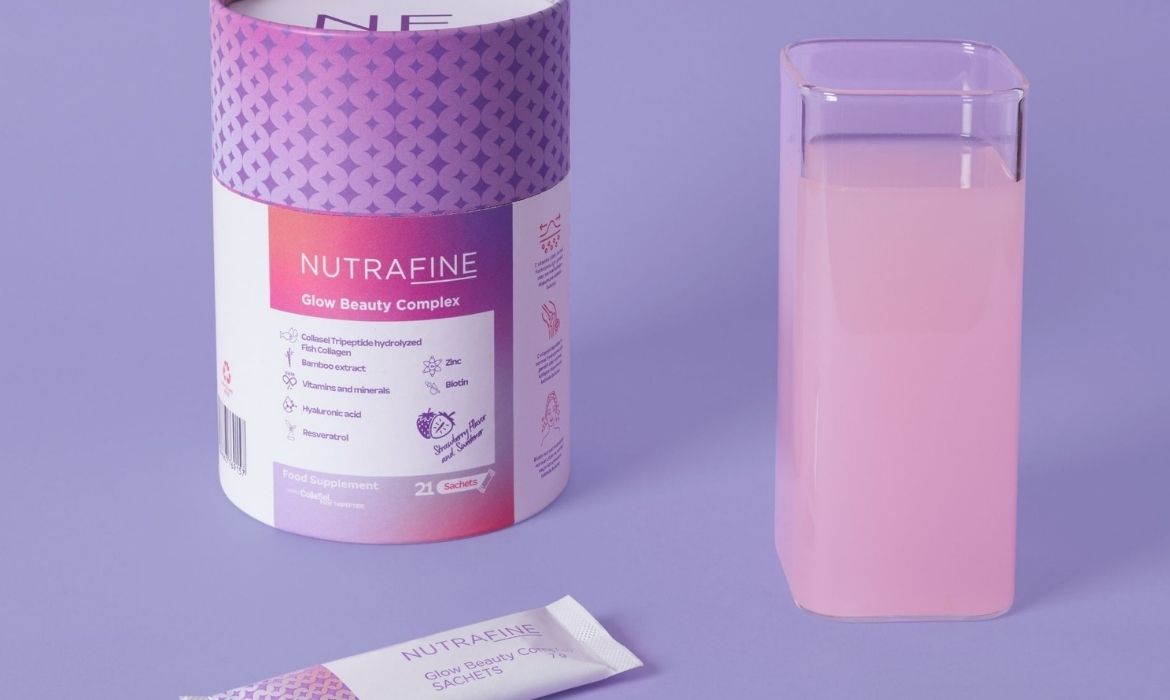Nutrafine Glow Beauty Complex
-

- Dyt. Özge Bezirci
- 26 September 2025
COLLAGEN TRIPEPTIDE
Collagen tripeptide is a short peptide chain consisting of 3 amino acids, usually obtained from fish, pork, or bovine collagen via enzymatic hydrolysis. The most common sequence is Gly–Pro–Hyp (glycine–proline–hydroxyproline).
-
Molecular Weight: approximately 300–500 Dalton
-
Due to its low molecular weight, it is highly bioavailable, absorbed through the intestines, enters the bloodstream, and reaches target tissues.
1. Skin Health and Anti-Aging Effects
-
Stimulates fibroblasts to increase the production of collagen, elastin, and hyaluronic acid.
-
Exhibits antioxidant effects and may reduce UV damage.
-
Studies:
-
Inoue et al. (2016): 8-week supplementation of 3 g collagen tripeptide in women significantly increased skin moisture, elasticity, and dermal collagen density.
-
Proksch et al. (2014): Hydrolyzed collagen peptides, especially the tripeptide form, improved skin elasticity and reduced wrinkles.
-
2. Joint and Bone Health
-
Stimulates chondrocytes (cartilage cells) to support cartilage matrix.
-
Reduces inflammatory markers and improves joint pain.
-
Studies:
-
Iwai et al. (2005): 90% of orally administered tripeptide collagen entered the bloodstream within 6 hours, and part directly reached joint tissues.
-
Collagen tripeptide supplementation improved osteoarthritis symptoms.
-
3. Muscle and Sports Performance
-
Hydrolyzed collagen has limited direct effect on muscle mass but supports tendons and ligaments, reducing injury risk.
-
May support post-exercise recovery (Zdzieblik et al., 2015).
Typical Dosage: 2.5–5 g daily. Most studies report no serious side effects, but allergy risk should be considered for fish or bovine sources.
HYALURONIC ACID
Hyaluronic acid (HA) is a glycosaminoglycan (GAG), a long-chain polysaccharide naturally present in connective tissue, skin, synovial fluid, and eyes.
-
Key Feature: High water retention; 1 g HA can bind ~1 liter of water.
Biological Functions
-
Moisture and Tissue Elasticity: Retains water around dermal fibroblasts, improving skin hydration and elasticity.
-
Joint Health: Major component of synovial fluid; provides lubrication and shock absorption.
-
Wound Healing and Cell Migration: Facilitates fibroblast and keratinocyte migration, aiding tissue repair.
-
Antioxidant and Anti-inflammatory Effects: Neutralizes free radicals and modulates inflammation.
Applications
-
Dermatology & Cosmetics: Topical creams/serums improve hydration, reduce wrinkles, and strengthen the skin barrier.
-
Evidence: 2014 RCT showed topical HA significantly improved skin hydration and elasticity.
-
-
Joint Treatment (Osteoarthritis): Intra-articular injection improves mobility and reduces pain.
-
Evidence: 2019 Cochrane review reported HA injections are more effective than placebo for short-term pain relief.
-
-
Eye Health: Eye drops for dry eye treatment.
-
Oral Supplements: Oral HA is absorbed via the intestines and may improve skin moisture.
-
Evidence: 2017 meta-analysis showed oral HA increased skin hydration within 4–12 weeks.
-
Safety: Generally safe; serious side effects are rare. Injections should be administered by professionals to avoid infection, edema, or allergic reactions.
References:
-
Fraser JR et al., J Intern Med, 1997.
-
Pavicic T. et al., J Clin Aesthet Dermatol, 2014.
-
Jevsevar DS. et al., Cochrane Database Syst Rev, 2019.
-
Kawada C. et al., Nutrients, 2017.
JAPANESE KNOTWEED EXTRACT (Polygonum cuspidatum)
-
Also known as Reynoutria japonica, rich in resveratrol.
-
Native to Asia (Japan, China, Korea).
Key Bioactive Compounds:
-
Resveratrol (trans-resveratrol, high bioavailability)
-
Emodin
-
Polyphenols
-
Anthocyanins
Biological Effects
-
Antioxidant: Neutralizes free radicals, reduces oxidative stress.
-
Cardiovascular Protection: Improves endothelial function, reduces arterial stiffness, inhibits LDL oxidation.
-
Anti-inflammatory: Suppresses NF-κB and COX-2 pathways.
-
Neuroprotective: Potential protective role in Alzheimer’s and Parkinson’s diseases.
-
Metabolic Effects: Improves insulin sensitivity and supports glucose metabolism.
Applications: Supplements (resveratrol capsules), anti-aging products, cardiovascular and neurological health.
Safety: Generally safe; high doses of emodin may cause laxative effects. May interact with blood-thinning medications (warfarin, aspirin). Not recommended during pregnancy or breastfeeding due to insufficient data.
BAMBOO EXTRACT
-
Typically from Bambusa vulgaris or Phyllostachys pubescens.
-
Key Feature: High silica content (up to 70% of dry weight), plus polyphenols, amino acids, and minerals.
Benefits
-
Connective Tissue and Skin Health: Silica supports collagen synthesis and strengthens connective tissue; used for hair, skin, and nails.
-
Bone Health: Supports calcium metabolism, may increase bone mineral density.
-
Antioxidant Effects: Polyphenols neutralize free radicals and reduce oxidative stress.
Risk: Excessive intake may increase kidney stone risk, especially in predisposed individuals.
VITAMIN C
-
Water-soluble antioxidant vitamin essential for various biochemical processes; humans cannot synthesize it and must obtain it from diet.
-
Chemical Name: L-ascorbic acid
-
Active Forms: Ascorbic acid and dehydroascorbic acid
Biological Roles
-
Antioxidant – neutralizes free radicals and reduces cell damage.
-
Collagen synthesis – necessary for skin, blood vessels, bones, and connective tissue.
-
Enhances iron absorption.
-
Supports immune system.
-
Neurotransmitter synthesis – dopamine to norepinephrine.
-
Carnitine production – essential for fatty acid transport and energy metabolism.
Clinical Importance
-
Strengthens immune system – may reduce duration and severity of colds.
-
Antioxidant and cell protection – protective against chronic diseases.
-
Skin and collagen health – accelerates wound healing, protects against UV damage, supports dermal collagen synthesis.
-
Enhances iron absorption in vegetarian/vegan diets.
Safety: Generally safe at high doses (500–2000 mg/day), but caution for individuals prone to kidney stones.
Deficiency (Scurvy): Fatigue, gum bleeding, bruising, poor wound healing; higher risk in poorly nourished individuals and the elderly.
ZINC
-
Essential mineral for immune function, cell regeneration, DNA/protein synthesis, and reproductive health.
-
Must be obtained from diet, as the body does not store it.
Functions & Benefits
-
Supports immune system – may shorten duration of colds and infections.
-
Promotes wound healing and cell regeneration.
-
Essential for DNA and protein synthesis.
-
Supports skin and hair health; may prevent acne and hair loss.
-
Hormonal balance – regulates testosterone and estrogen; improves male fertility.
-
Cognitive function – supports memory and brain health.
-
Eye health – reduces risk of macular degeneration.
-
Regulates appetite and taste – deficiency may reduce taste and smell.
Food Sources: Meat, seafood, nuts, seeds, legumes, dairy, eggs, whole grains, and some vegetables.
Deficiency: Weak immunity, slow wound healing, hair loss, taste/smell disorders, skin problems, low appetite, poor memory, low sperm quality in men.
Recommended Daily Intake:
-
Men: 11 mg
-
Women: 8 mg
-
Pregnant: 11 mg
-
Lactating: 12 mg
-
Children: 2–8 mg (depending on age)
Excess: >40 mg/day may cause nausea, vomiting, weakened immunity, and copper deficiency.
VITAMIN B5 (PANTOTHENIC ACID)
-
Water-soluble vitamin essential for energy production, hormone synthesis, and fat metabolism. “Pantothenic” means “everywhere” in Greek, reflecting its presence in many foods.
Functions
-
Energy Production: Converts carbs, proteins, and fats into energy (ATP).
-
Fatty Acid Metabolism: Supports breakdown and utilization of fats.
-
Hormone Production: Involved in cortisol, testosterone, and estrogen synthesis.
-
Skin & Hair Health: Supports skin regeneration, may prevent hair loss.
-
Nervous System Support: Enhances brain function and memory.
-
Wound Healing: Accelerates tissue repair through cell regeneration.
Sources: Meat, fish, dairy, whole grains, legumes, vegetables, nuts, eggs.
Deficiency: Rare, but may cause fatigue, irritability, headache, tingling, digestive issues, cramps.
Excess: Usually excreted in urine; very high doses (>10 g/day) may cause GI upset.
Recommended Daily Intake:
-
Adults: 5 mg
-
Pregnant: 6 mg
-
Lactating: 7 mg
COLECALCIFEROL (VITAMIN D3)
-
Form of vitamin D found in animal sources or synthesized in skin via sunlight (UVB).
Production: 7-dehydrocholesterol in the skin converts to cholecalciferol when exposed to UVB (290–315 nm).
Functions:
-
Bone & Calcium Metabolism: Enhances absorption of calcium and phosphorus; regulates parathyroid hormone. Deficiency increases risk of rickets, osteomalacia, and osteoporosis.
-
Immune Support: Modulates T and B lymphocytes; increases antimicrobial peptides; may reduce respiratory infections.
-
Neurological & Metabolic Health: Vitamin D receptors in brain; affects oxidative stress, inflammation, neurological function; linked to type 2 diabetes and depression.
Forms: Drops, capsules, tablets, ampoules; may be combined with calcium; used under medical guidance.
BIOTIN (VITAMIN B7)
-
Water-soluble B vitamin; acts as a coenzyme in carbohydrate, fat, and protein metabolism. Found in eggs, nuts, whole grains, legumes; partially synthesized by gut microbiota.
Health Effects
-
Hair, Skin & Nail Health: Deficiency causes hair loss, brittle nails, skin rashes.
-
Evidence: 2017 review – supplementation improved hair/nail health in deficient individuals.
-
-
Metabolic Health: Potential benefits in diabetes and obesity (glucose homeostasis, insulin sensitivity).
-
Pregnancy & Child Health: Biotin metabolism increases during pregnancy; deficiency may affect neural tube development.
-
Nervous System Health: Supports nerve metabolism; used in rare inherited metabolic disorders (biotinidase deficiency).
Deficiency Symptoms: Hair loss, eyebrow/eyelash loss, skin rashes (especially around mouth), fatigue, depression, growth retardation in infants, low muscle tone.
Risk Groups: Long-term antibiotic users, anticonvulsant therapy, pregnant women, high raw egg white intake (avidin binds biotin).
Safety: No known toxicity; excess is excreted in urine. High doses may interfere with lab tests (thyroid, troponin).


 NL
NL
 ENG
ENG
 DE
DE